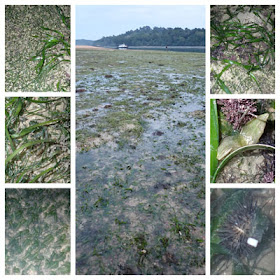Pulau Sekudu is off limits since 2007 and requires special permission from NParks. Thanks to NParks for permission and support to do these predawn low spring tide surveys of the island.
There were still a few colourful patches of large, well grown sponges. Although they seemed fewer and smaller than what we saw in Aug 2023 - which was similar to what we saw in Jun 2022 and Dec 2021. The 'nudi rocks' were colourful with sponges too and Chay Hoon spotted many nudis. I will update the post with team photos later.
Today, I saw a good variety of small sea fan colonies, similar to what we saw in Aug 2023. Many of the sea fans were overwhelmed by seaweeds. Surprising as we saw larger and more sea fans at Ubin jetty and Changi recently.
Like most of our northern shores, the stars of this shore are the echinoderms. I saw 2 Knobbly sea stars and one Painted sand star, but the rest of the team saw more and different sea stars. Unfortunately none of us saw Biscuit sea stars, we saw them in Aug 2023 but they were missing in 2020 and 2021. The usual common 'northern' sea cucumbers were also seen: Thorny sea cucumber, Pink warty sea cucumber (though these two not as plentiful as seen on Changi). Today, I saw many Big synaptid sea cucumbers. The long time resident Diadema sea urchin is still there - and the tiny Diadema we saw last year were larger. I saw a few White sea urchins, and a lot of small Black sea urchins!
As usual, the rest of the team make all the special finds. Lots of different fishes, some we haven't seen before on Sekudu. Also other sea stars, colourful snails and slugs.Here's a compilation of the 9 Knobbly sea stars seen by the team. These sea stars have unique colours, and patterns of knobs. So it was (relatively) easy to omit duplicates. We didn't see any young ones. Many of the sea stars had little hitch-hikers: porcelain crabs, brittle stars, synaptic sea cucumbers. We saw more Knobblies during our last survey in Aug 2023, 26 including 3 that were relatively young.
I checked on the corals here for impact by global mass coral bleaching. I saw about 15 small to medium sized Boulder pore corals. Most were nice and well formed, brown. 4 had white patches, a few had small recently dead patches. I saw patches of Zebra coral on the high shore and they were okay. But I didn't come across the Pock-marked coral colony and Boulder sandpaper coral colony that I had in the past. The rest of the team saw one large Disk coral (not bleaching) and a small one (bleaching).
Other cnidarians can also bleach, so I looked out for those. I saw one bleaching Snaky anemone, and sprinkles of bleaching Posy anemones. All the small colonies of Spiky flowery soft corals were bleaching. But I did not see any bleaching among the many Haddon's carpet anemones that were still everywhere. There were also many Flowery sea pens, some Swimming anemones and cerianthids - all healthy.
The NOAA prediction for the Singapore Strait seems to suggest that sea temperatures will ease in the weeks ahead. Let's hope we have indeed passed the peak of mass coral bleaching and that our reefs will start to recover.
The seagrasses were growing lush, green and clean (no epiphytes)! Lots of Spoon seagrass (both small and large leaf blades) and Needle seagrass (narrow and broad leaf blades). There was small but lush patch of Fern seagrass at the eastern most edge of the island. The Serrated ribbon seagrass are still growing in sparse patches from the mid-water mark to the low tide line. I saw two clumps of Tape seagrass on the arm of the lagoon, as well as 3 small clumps in the middle of the lagoon. Unfortunately, the leaves were only about 50cm long. One had male flowers and little black sea urchins were clinging onto one clump in the lagoon. I looked but couldn't see dugong feeding trails.
What is the fate of Pulau Sekudu?
Chek Jawa and Pulau Sekudu is slated for reclamation in the Long-Term Plan Review. The plan includes a road link (black line) from the mainland jumping off at Punggol, crossing to Pulau Ubin through Chek Jawa to jump off to Pulau Tekong before circling back to the mainland on Changi East. Proposed reclamation (in yellow) will bury Pasir Ris shores, Pulau Sekudu and Chek Jawa as well as a large stretches of Changi Beach.

The Singapore Blue Plan 2018
Among the Proposed Areas for Immediate Conservation Priority, the Singapore Blue Plan 2018 proposes that the intertidal and subtidal marine areas of Pulau Ubin to be designated Marine Reserve.
The proposed area would include Tanjung Chek Jawa, the largest known intertidal area in northern Singapore. Considered one of the richest in Singapore, Chek Jawa comprises many adjacent ecosystems: coastal hill forest, mangrove areas, rocky shores, seagrass meadows, coral communities, and sandy areas. Chek Jawa remains an icon of celebration and hope for many Singaporeans since its reprieve from reclamation in 2001.
DOWNLOAD the Plan, SUPPORT the Plan! More on the Singapore Blue Plan 2018 site.
Photos by others on this survey
Richard Kuah
Kelvin Yong Part 1
Part 2
Marcus Ng
Chay Hoon
Muhd Nasry











